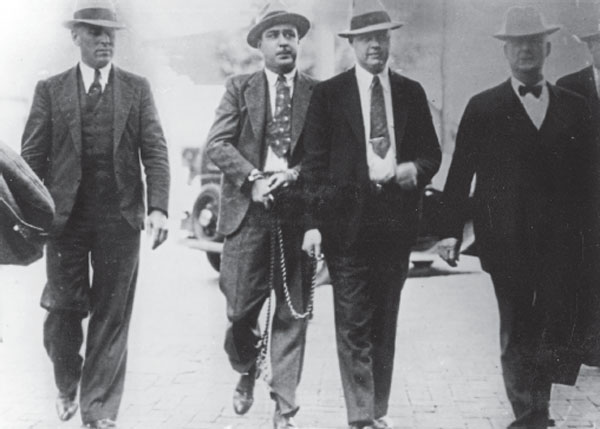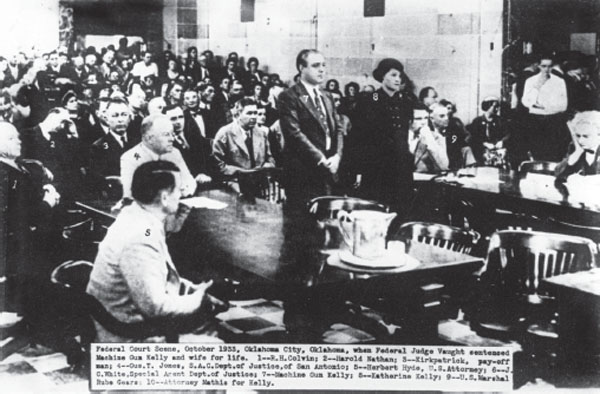
Machine Gun Kelly, off to prison. Western History Collections, University of Oklahoma Libraries .
8
“MACHINE GUN” KELLY
KING OF THE TULSA RUMRUNNERS
After making the FBI list of public enemies and getting himself captured, “Machine Gun” Kelly became sentimental. “I got my start in 1928,” he whined over a decade later. “The biggest mistake I ever made was leaving Tulsa.”
George Barnes once claimed that he was “king of the rumrunners” in Tulsa. And that was saying something. Tulsey Town had been a dusty stop on a cattle trail, second only to Catoosa, the hellhole of Indian Territory in booze, gambling and prostitution. That was in the years before a big oil strike at nearby Glen Pool turned Tulsa into the Oil Capitol of the World, drawing thousands of new people, many from sophisticated eastern cities. And of course, the grifters, gamblers and thieves came along for the ride.
Barnes had the quiet, easy drawl you would expect from someone who grew up in Memphis, but he was an outsider to the criminal underworld there, being upper middle class and Catholic. George became a bootlegger in high school, managed to get through two years of college and then dropped out to steal away the pretty young daughter of a wealthy businessman.
When young Mr. and Mrs. George Barnes returned from their elopement, “Daddy” bought him a series of business ventures, but even a small goat farm was too much for him to handle. When George returned to bootlegging full time as George R. Kelly and got arrested a few times, the marriage ended. He tried to begin anew in Santa Fe, New Mexico, but was convicted of illicit liquor sales on March 14, 1927, and sent to the state penitentiary for a brief stay.
He was released quickly enough to be named as a prime suspect in a Saturday night Tulsa robbery near Fourth and Main Streets on July 23, 1927. The next evening, George was arrested for vagrancy, pending other charges, but was eventually released for lack of evidence. The next year, in February 1928, he walked out of the federal court in Tulsa convicted of bootlegging again.
When he arrived at the federal prison in Leavenworth, Kansas, he met Frank “Jelly” Nash, who was part of the last train robbery in Oklahoma history only five years before. More importantly, Harvey Bailey, the “King of the Heist Men,” mentored him in professional bank robbery.
George was released in 1930 and ended up in the Silicon Valley of America’s Depression-era criminal elite. “Of all the Midwest cities,” former Tulsan Alvin “Creepy” Karpis said in his memoirs decades later, “the one I knew the best was St. Paul, and it was a crook’s haven. Every criminal of any importance in the 1930s made his home [there] at one time or another.”
While there, George helped pull off a job that the St. Paul Pioneer Press called “one of the most daring bank holdups since the days of the Younger Brothers and Jesse James gangs.” The heist, about one hundred miles west of St. Paul at Willmar, harvested $70,000, in cash—worth about $1.2 million in modern money—and as much in securities. Three of the robbers stole most of the loot from their accomplices.
One month later, they were found dead fourteen miles northeast of St. Paul. But by then, George was using his undersized share to court a new wife, who was born Cleo Brooks but called herself Kathryn. She married him on September 30.
George was in the crew that robbed $40,000 from the Central State Bank in Sherman, Texas, on April 3, 1931. And he helped take another forty at Denton, a North Texas town. After one more job in Tupelo, Mississippi, near Kathryn’s birthplace, George began planning a kidnapping. On January 27, 1932, George and an accomplice grabbed Howard Woolverton and his young wife out of a car in South Bend, Indiana, assuming that his family could make good on the $50,000 ransom demand. They couldn’t.
Kathryn was livid, but she had a plan. Although George Barnes didn’t really like weapons, she bought him a slightly used Thompson machine gun. She then kept the bar closed at the gang hideout, a farm owned by her stepfather, Robert “Boss” Shannon, near Fort Worth, until George had finished daily target practice. After Tulsa’s Barker gang collected $100,000 in ransom money for St. Paul beer mogul William A. Hamm, Kathryn, “Machine Gun” Kelly and their associate Albert Bates shrugged off a recently bungled abduction and headed north to Oklahoma City for one more try. Their target was an oil millionaire.
Charles Urschel started as an Ohio farm boy, served in the army during World War I and then moved west to the Oklahoma oil fields, where he went wildcatting with Tom Slick and eventually married Slick’s widow. Charles and Berenice realized that they might be kidnapping targets but fired a bodyguard for sleeping too much on the job and lived to regret it.
The Urschels were on the screened porch of their home in the exclusive Heritage Hills neighborhood playing cards with their friends Walter and Kelly Jarrett when the kidnapping went down on the evening of Saturday, July 22, 1933. Since the foursome wouldn’t say which of the two men was Urschel, both were shoved into the getaway car. And then things really went wrong.
Since criminal wizard Machine Gun Kelly forgot to fill the getaway car with gas, they were stranded for an hour while the driver went to get some. Later, after releasing Walter Jarrett, the driver fell asleep, ran the car into a ditch and couldn’t find the hideout near Fort Worth without asking for directions from a bewildered farmer, who remembered them.
Worse still, in the days to come, Charles Urschel used his photographic memory to record everything he experienced at the Ora Shannon farm. Since the gang hadn’t taken his watch, Urschel timed airplanes passing overhead daily, even as his friend Charles Colcord, a frontier deputy U.S. marshal who made a fortune in oil and real estate, offered a $10,000 reward for George Kelly, dead or alive.
When the $200,000 ransom—about $ 3.6 million in modern money—arrived in Fort Worth, everyone, including Urschel, celebrated. Eventually, he was dumped on the north edge of Norman, Oklahoma, with just enough cab fare to get home.
The Kellys, no doubt, knew about the Lindbergh baby kidnapping and murder but probably didn’t realize that they had now become the first suspects targeted under the new Lindbergh law, which made the Federal Bureau of Investigation the lead agency in most kidnappings. Nor did they know that Urschel had been sneaking peeks at all of them from beneath his blindfold as he recorded the critical data that led the FBI to the Ora Shannon farm on Saturday, August 12.
George and Kathryn were already on the run, but George’s old mentor, Harvey Bailey, was pulled out of the outdoor hammock where he was dozing with ransom money stuffed in his pockets. Naturally, the jury didn’t believe that he was innocent of the kidnapping, but this time, he probably was. Kathryn’s beloved mother, Ora, was also snagged in the dragnet and thrown into a local hoosegow.

Machine Gun Kelly, off to prison. Western History Collections, University of Oklahoma Libraries .

Machine Gun Kelly at sentencing. Western History Collections, University of Oklahoma Libraries .
And with that, Kathryn tried to turn informant and had George write a letter threatening the whole Urschel family, even as the net began to close in September 1933.
They were hiding where everything had begun for George, back in Memphis. And neither one of them ever said, “Don’t shoot, G-men,” despite later FBI claims. Instead, Machine Gun Kelly quietly muttered, “I’ve been waiting for you all night” and put on his own handcuffs.
Thirteen days after their first appearance before Judge Edgar S. Vaught, he gave Kathryn and George life sentences. “Be a good boy,” Kathryn said as George was led away. She never saw him again. Machine Gun Kelly died on his fifty-ninth birthday at Leavenworth in 1954. Charles Urschel, of all people, anonymously financed the college education of Kathryn’s daughter, Pauline, with Judge Vaught acting as intermediary, despite the many times the Kelly gang threatened to kill him.
And about half of the $200,000 ransom paid to return Charles Urschel home alive has never been found.